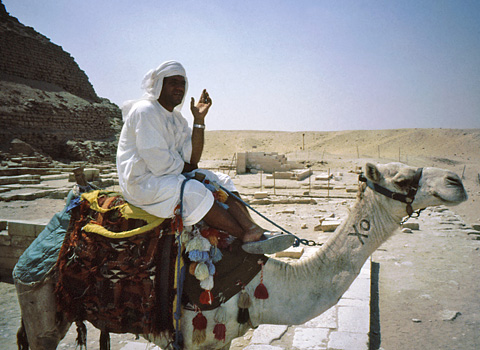Introduction to Saqqara
Saqqara is the location of the principal necropolis of ancient Memphis, dating from the time of the foundation of the city. The site covers an area of 900 hectares, crowded with burials which span the much of the whole period of Egyptian antiquity. A day-trip to Saqqara will allow the visitor only a brief tour of the major monuments from among the vast number of remains there are to see. The monuments are generally divided into two areas. North Saqqara includes the Step Pyramid and Old and New Kingdom cemeteries and South Saqqara, is the area from the Pyramid of Pepy I and the other pyramids immediately to the south.

The plateau contains a great number of massive tombs belonging to members of the first royal families and high officials from Dynasty I onwards. There are two large underground structures at Saqqara (perhaps once having a superstructure) which archaeologists believe may be tombs of Dynasty II kings Hetepsekhemwy and Nynetjer because seal impressions of those kings were found there. The name of the first ruler of unified Egypt, Narmer, whose tomb is at Abydos, is also known at Saqqara and later Dynasty I tombs are attested at the site. The development of the Early Dynastic mastaba tombs for the Memphite elite in the Saqqara region were undoubtedly prototypes for the largest of the royal monuments here. Many of the Early Dynastic rulers appeared to have funerary monuments at both Saqqara and Abydos and there is much debate between archaeologists about which site contained the actual burials of these rulers. Recent opinion however, seems to have shifted away from regarding the Saqqara tombs as being royal at all and they are now being seen as tombs of the wealthy elite of the period.
The most famous monument at Saqqara is the step pyramid complex of Djoser (Dynasty III) which was thought to be the first large funerary monument constructed in stone. Much of its architecture is based on the natural materials which had previously been used in the construction of royal tombs and temples. This is the monument most people come to visit. Djoser’s successor, Sekhemkhet, attempted to construct his pyramid complex nearby, it was abandoned soon after it was begun and is now known as the ‘buried pyramid’.

The area was abandoned as a royal necropolis for most of Dynasty IV, the kings turning to Meidum, Dashur and Giza for their burial sites and it was not until the reign of Shepseskaf at the end of Dynasty IV that the next large funerary monument was built at South Saqqara. This was followed by pyramids of Userkaf and Unas during Dynasty V and Teti in Dynasty VI. Djedkare, Pepy I, Merenre and Pepy II constructed pyramids at South Saqqara during Dynasties V and VI.

The remains of the small Dynasty VIII mudbrick pyramid of Iby at South Saqqara shows the decline in the economic system during the First Intermediate Period. During the Middle Kingdom the focus once more swung away from Saqqara towards the regions further south and the last pyramid to be built at South Saqqara was that of the Dynasty XIII King Kendjer, the only pharaoh of this dynasty known to have completed a pyramid as his funerary monument.
Many important officials resided in Memphis during the New Kingdom and although the kings of the period are known to have been buried at Thebes, many of the elite constructed elaborate tombs at Saqqara. Many of these tombs, to the south of the Unas causeway were recorded by Karl Lepsius during the mid-19th century and have been rediscovered since 1975 by a joint British and Dutch expedition. In this area there are many very fine tombs of late Dynasty XVIII and early Dynasty XIX especially that of General Horemheb’s private tomb.
To the north-west of the Step Pyramid are the animal cemeteries, including tomb galleries of mummified baboons, ibis and falcons as well as the ‘Serapeum’ – the underground galleries in which the sacred Apis Bulls were buried. From the Late Period onwards there were vast numbers of animals, including dogs or jackals and cats being embalmed and buried in huge catacombs.

Near the resthouse towards the Serapeum there is a curious semicircle of Greek statues known as the ‘Philosopher’s Circle’. These statues were set up by Ptolemy I as a wayside shrine and the best-preserved figures include Plato, Protagoras and Homer.
Many of the tombs at Saqqara have been lost, their stone robbed for later building work such as the Monastery of Apa Jeremias and other Coptic monasteries in the area. The necropolis, however, is a vast site and there are still a great number of monuments open to visitors which will be a source of varied information covering a wide period of Egyptian history.
Tickets for entrance to the archaeological site of North Saqqara are EGP 60.
